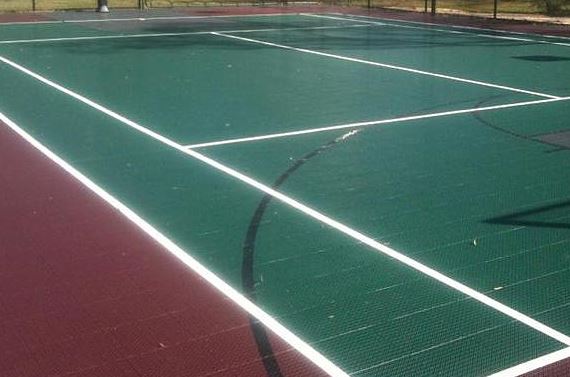Tennis Court Surfaces | Comparing Tennis Court Playing Surfaces
Question: What are the different types of tennis court surfaces?
Answer: There are three main types of tennis court surfaces. Acrylic Hard Court Surfaces, Clay, & Grass
Some companies produce similar hybrid tennis court surfaces, but the main three categories are widely used across the world on tennis courts. The largest tennis tournaments in the world (Grand Slams) also use a variety of these surface types:
- US Open = Hard tennis court surfaces (Acrylic)
- Australian Open = Hard tennis court surfaces (Acrylic)
- French Open = Clay tennis court surfaces
- Wimbledon = Grass tennis court surfaces
Hard Court Surfaces | Acrylic
Hard courts are the most common and widely used tennis court surfaces throughout the world, and especially in the United States. Hard courts are constructed from asphalt or concrete bases, and usually coated with 100% acrylic color coating systems. Here is a list of pros and cons when considering acrylic hard court surfaces:
Pros:
- Very low maintenance
- Large variety of surface color options
- Cleaner to play on, in comparison with other surfaces
- Very customizable surface pace, from slow to fast play
- Best for multi-sport courts
- Also available in cushioned options (Cushioned Hard Courts) for softer surfaces
- Good for both indoor and outdoor courts, in all climates. Semi-permeable to allow vapor transmission in areas with high water tables or poor drainage
- Drain and dry off quickly after rain
Cons:
- Can be a little harder on the body and joints in comparison with clay and grass courts
- Still need to maintain on occasion (crack filling, general cleaning, resurfacing, etc.)
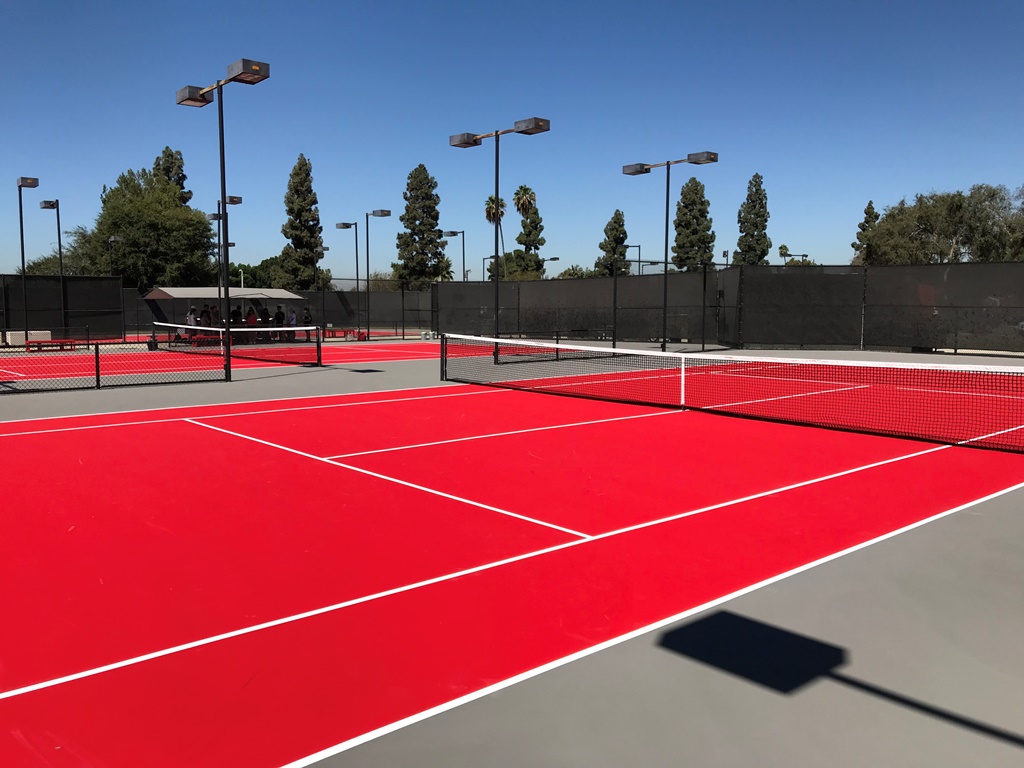
Acrylic Tennis Court Surface
Clay Tennis Court Surfaces | Natural Clay & Fast dry courts
Clay courts, like grass and synthetic turf, are classified under the “soft court” category. There are a few varieties from natural clay to fast dry court surfaces. Natural clay is a blend of sand and silt, and fast dry courts are made from crushed stone or brick and some form of binder. Both surfaces are installed over a compacted stone base & sub-grade. Clay court surfaces require watering, rolling, and brooming for ideal playing conditions, so they are normally shut down during freezing winter conditions. There are sub-irrigated systems available, as well as the original surface-watered courts. Regions where clay is more commonly used are Europe, Central & South America, and the eastern/southeastern United States. Clay tennis court surfaces play slow with a higher bounce to produce longer rallies. Here is a summary of points on clay courts:
Pros:
- Softer playing surface
- Ability to slide during play
- Fast dry courts drain quickly after a rain, to resume play (natural clay drains slow)
Cons:
- High maintenance with water, rolling & brooming
- Annual top-dressing is recommended
- Watering (and maintenance) can be costly & time consuming
- Clay materials can be messy on shoes, clothes, and around courts
- Limited colors available
- Not able to play in all weather conditions (winter)
- Only able to achieve slow playing conditions
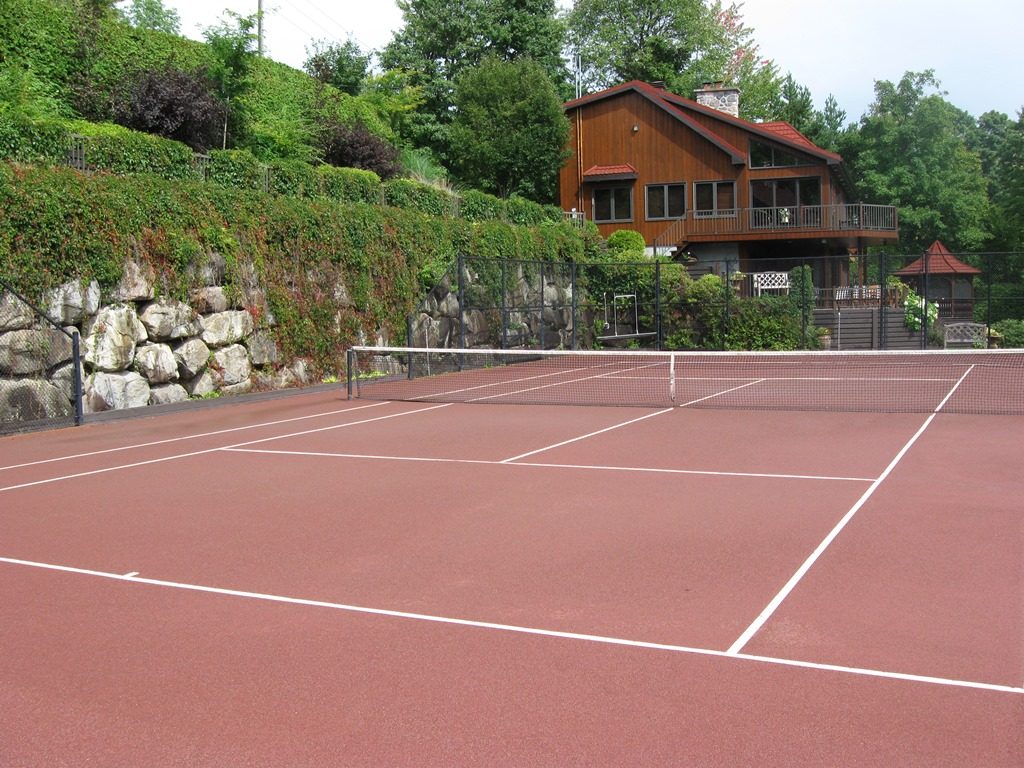
Red Clay Tennis Surface
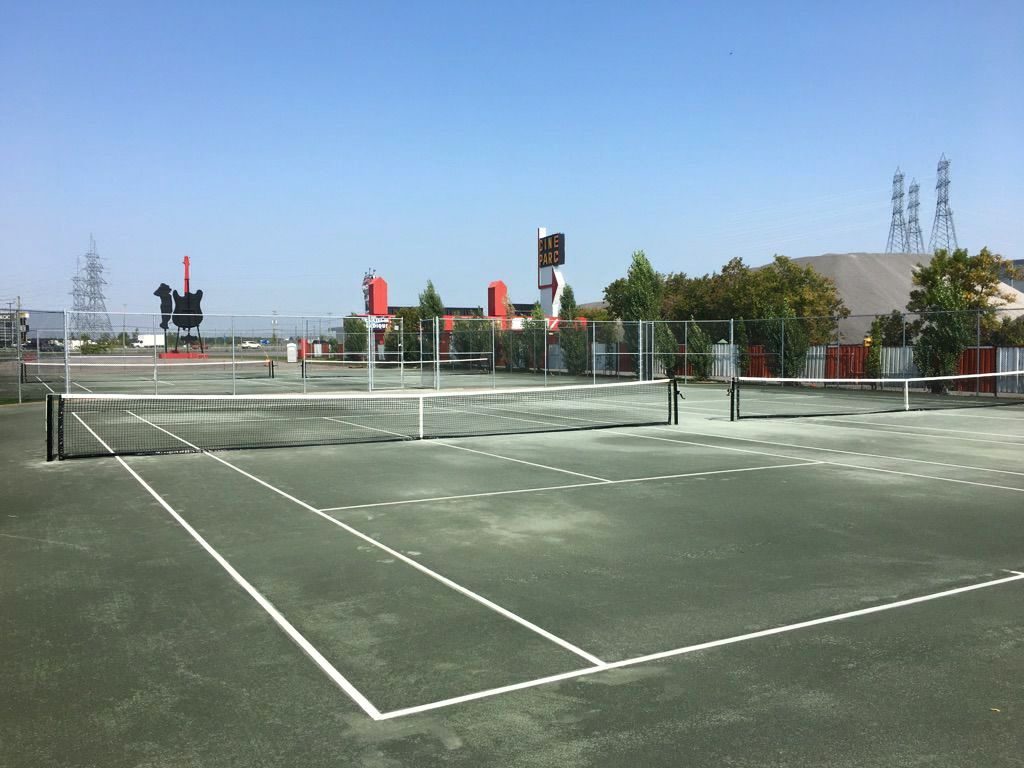
Green Clay Tennis Court Surface
Grass Tennis Court Surfaces | Natural grass and Synthetic Turf
The third main category of tennis court surfaces is grass. There are two sub-categories, natural grass and infilled synthetic turf. Infilled synthetic turf is artificial grass that is usually filled with sand. This helps to stand the blades of grass up and provide a solid surface to rebound the ball. Natural grass has a medium dry time, after rain, and synthetic grass dries fast. Both types of grass tennis court surfaces exhibit fast playing conditions with softer playing surfaces under foot. When it comes to grass courts, there is still quite a bit of planning and maintenance required. Natural grass courts need correct soil conditions, water, and the right grass species for the regional environment. Here are some pros and cons when considering grass tennis court surfaces:
Pros:
- Soft playing surface & allows sliding during play
- Cooler surface in hot weather conditions
Cons:
- High maintenance: watering, mowing, fertilizing, top dressing, striping
- Need to be careful with “overplaying” – Alternate play to prevent wear
- Only green color available for natural grass
- Synthetic grass requires brooming and addition of sand. Can also have issues with mold.
- Grass courts play fast with low ball bounce.
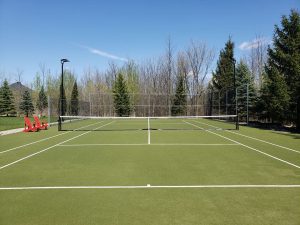
Grass Tennis Court Surface – Synthetic
Modular Tennis Court Surfaces | Interlocking Plastic Tiles
Another sub-category, that somewhat falls under hard courts, is modular tennis court surfaces. These are usually interlocking tiles made from plastic. There are a variety of different brands and they are generally produced in different colors with nubs on the surface to provide better traction. They still require a solid base made from either asphalt or concrete, so you can’t safe money by foregoing that expense. This is another short list of obvious pros & cons:
Pros:
- Good for hard courts with drainage issues that would normally cause blisters in coatings
- Ideal as a modular or temporary surface (special events, promotions, etc.)
- Initial aesthetics are good, with large variety of colors and logos
Cons:
- Cost of modular tiles are expensive (approximately 4 times more than coatings)
- Substantial fading and cracking usually noticed around 10 years of age
- Open grid collects organic debris (leaves/pine, needles, etc.) and difficult to clean out without taking apart entire court
- Slippery to play on, especially when wet
- Fast and low bounce for tennis
- Tiles can migrate or move with the slope of a standard tennis court base (1% slope)
